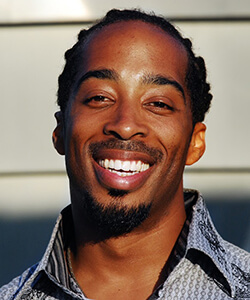Want to improve your presentation skills? This poetry-slam champion recommends a more human approach to create a connection with your audience.
 Bullet points rule the business world. In the age of too much information, we often condense paragraphs of prose into short lists of sentence fragments. Get to the point, we tell ourselves, because this audience needs to attend other meetings and finish other projects. Sekou Andrews, actor, musician, two-time national poetry slam champion, and creator of the “poetic voice” style of public speaking, believes that too often those bite-sized nuggets of information and lists of key takeaways don’t connect on an emotional level. “At the end of the day, no matter what the bullet points are or what the corporate mission statement says, we need to remember that we’re serving people,” Andrews told PCMA in advance of his keynote session at the PCMA Education Foundation Partnership Summit. “We are serving human beings, and human beings are not motivated to join a movement or embrace an idea by data points alone.”
Bullet points rule the business world. In the age of too much information, we often condense paragraphs of prose into short lists of sentence fragments. Get to the point, we tell ourselves, because this audience needs to attend other meetings and finish other projects. Sekou Andrews, actor, musician, two-time national poetry slam champion, and creator of the “poetic voice” style of public speaking, believes that too often those bite-sized nuggets of information and lists of key takeaways don’t connect on an emotional level. “At the end of the day, no matter what the bullet points are or what the corporate mission statement says, we need to remember that we’re serving people,” Andrews told PCMA in advance of his keynote session at the PCMA Education Foundation Partnership Summit. “We are serving human beings, and human beings are not motivated to join a movement or embrace an idea by data points alone.”
Andrews has redefined the traditional motivational keynote speech in presentations he has made to major companies, including Nike, eBay, and LinkedIn. You won’t find him standing behind the podium offering a canned perspective on innovation (watch here for proof). While Andrews acknowledged that an audience might occasionally see some PowerPoint slides behind him, he said that they’re “always the icing on the cake. They might add some extra bling to the presentation, but they’re not my crutch.”
If you’re like most of the working world, PowerPoint is more than your crutch — it carries your presentation. Instead of thinking about the order of your slides or which graph will best illustrate your data, Andrews believes that one element can elevate the success of any presentation: storytelling.
“When I’m trying to share techniques for speaking and engagement with an audience, none of it matters if the participants refuse to see themselves as storytellers,” Andrews said. “I have encountered the wall of ‘I’m not a storyteller’ with so many business professionals.”
No matter who you are or what role you serve in a business setting, though, Andrews believes that you are a storyteller. “I tell participants in my training programs that, after they leave, they will tell at least five stories,” Andrews said. “They might tell someone the story of how they met their partner. They might go home and tell their spouse what happened during the day. As human beings, we are natural storytellers. One of the very first lessons in learning how to speak is through the stories we hear as children.”
So why do so many of us fail to recognize our natural talents to tell tales? “The problem is that many of us disconnect our business agendas from our ability to tell stories,” Andrews said. “Consider the setting of being at a dinner party where your human agenda is to connect with other people and find shared moments that generate laughter and emotion. When we leave that environment, many of us feel that we must shift to a formal business agenda that serves only to display authority and demonstrate certain competencies.”
Instead of focusing on speaking the corporate language of data, bullet points, and PowerPoint slides, Andrews offered a simple lesson to keep in mind. “Remember that the human beings you met at that dinner party are the same human beings in the board room,” Andrews said. “Insist on telling stories that will connect with them emotionally. Once you learn to embed your strategy into stories, the data will still be there, but it will be buried beneath what really matters: an inspirational, engaging, and dynamic approach to communicating that will paint new possibilities and make your presentation more memorable.”

